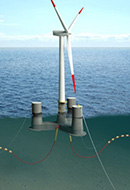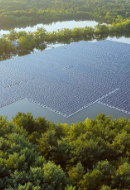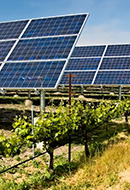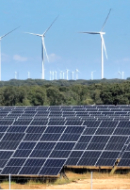Home automation
The home automation revolution
The television, the fridge and even the coffee maker are now smart. Virtual assistants powered by artificial intelligence coordinate our devices and learn from our habits to make our lives more comfortable and efficient. Home automation is no longer the future – it is the present, transforming the way we live in our homes.
 SEE INFOGRAPHIC: The smart home [PDF]
SEE INFOGRAPHIC: The smart home [PDF]
The alarm in your mobile phone goes off. When you turn the alarm off for the second time, the coffee maker starts to prepare your breakfast while the dimmer system gradually increases the brightness of your lights, simulating a warm sunrise inside your bedroom. The electric heater was programmed with the alarm time and started to heat the water half an hour before this time. It will lower the temperature by two degrees today, combining comfort and energy savings, since it is not as cold outside and temperatures are rising.
You wake up, walk to the living room and ask your virtual assistant to turn on the radio. The radio knows that you like to tune to the sports station on Mondays at 08:00 am to listen to the results of the weekend matches. The radio notifies you about a traffic accident that will delay you on your way to work with a warm message without any command. When you sit in your car, your GPS will have already calculated a quicker alternative route.
It’s not science fiction: it’s everyday life in a smart home, where appliances, sensors and artificial intelligence systems work together to provide comfort, security and efficiency. The Internet of Things has matured and become part of our daily lives, creating homes that learn, anticipate and care – for people and for the planet.
The smart home and its evolution
The smart home is no longer a promise for the future but a reality in full expansion. In recent years, the integration of virtual assistants, sensors, artificial intelligence and interoperable systems has consolidated a rapidly growing market that is transforming the way we live in our homes.
The adoption of home technology follows a pattern closely linked to key life moments: the birth of a baby drives the installation of connected cameras and security sensors; a move or renovation prompts the automation of lighting or thermal control; and the pursuit of comfort and energy savings encourages many people to incorporate smart devices into their daily lives.
Age, lifestyle and environmental awareness are now decisive factors. New generations demand total connectivity and mobile control, while older users value the security, wellbeing and remote assistance that technology provides.
Growth of connected households in the United States
In 2022 57 million
In 2023 63 million
In 2024 68 million
It is estimated that 45% of American households have at least one smart device.
Home automation: Consumer preferences

Voice assistants
In the UK, around 50% of the population owns at least one smart speaker.

Smart thermostats
One of the most prominent devices in use, favoured due to energy costs.

Smart lighting
Light bulbs, connected lights, and light control systems are among the common devices.

Voice assistants
In the UK, around 50% of the population owns at least one smart speaker.

Smart thermostats
One of the most prominent devices in use, favoured due to energy costs.

Smart lighting
Light bulbs, connected lights, and light control systems are among the common devices.
Virtual assistants
In 2013, the film Her imagined a future in which a sensitive, personable artificial intelligence accompanied a person’s daily life. More than a decade later, that fiction no longer feels so distant. Virtual assistants have become the voice and brain of the connected home, able to understand natural language, anticipate our routines and coordinate an entire ecosystem of smart devices.
The most popular virtal assistants
- Siri
2012
- Cortana
2014
- Alexa
2015
- Google Home
2016
- Bixby
2017
Today, names such as Alexa (Amazon), Google Assistant, Siri (Apple) and the more recent Copilot (Microsoft / OpenAI) coexist in millions of homes. They do more than respond to commands: they manage lighting, adjust the temperature, play music, make purchases, read messages, monitor security, and even summarise emails and the day’s news.
Smart speakers remain their most visible face – Amazon Echo, Google Nest, Apple HomePod – but assistants now inhabit our phones, cars, TVs and appliances.
The truly important factor is not the device, but the distributed intelligence that connects all elements of the home and continuously learns from the user. Current virtual assistants use generative artificial intelligence models to provide more natural, personalised responses, turning our interaction with technology into an increasingly human experience.
In figures, the global market for smart devices exceeds 25 billion active units in 2025, and the home virtual assistant category is one of the fastest-growing sectors, with projected values surpassing $400 billion, according to estimates from IDC and Statista.

Floating offshore wind
A milestone to boost renewables through innovation.

Floating photovoltaic solar energy
Do you know about floating photovoltaic solar energy?

Agrovoltaics
When agriculture and renewables go hand in hand.

Hybrid energy
When combining renewables makes them stronger.

Pumped-storage hydropower
Do you know what pumped-storage hydropower stations are used for?

Energy storage
The key to a decarbonised future.

Wind blade recycling
A new challenge for wind energy.


















